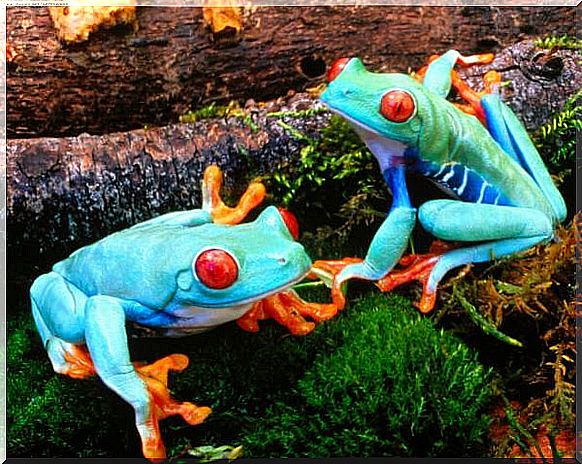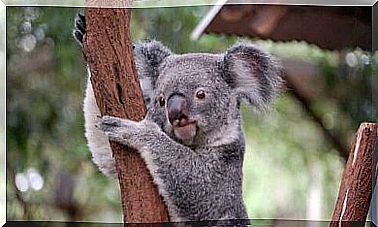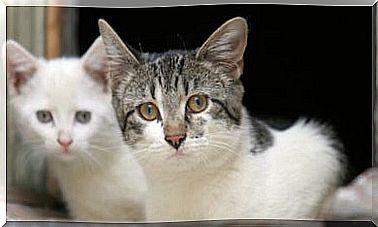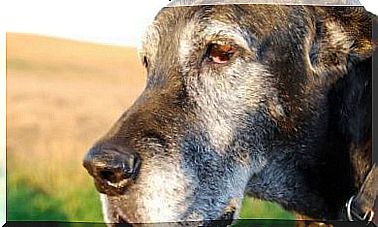The Poison Dart Frog

The poison dart frog is part of the Dendrobatidae family, possibly the most beautiful family of amphibians on the planet. However, their colors warn that they are highly poisonous: in fact, they are the most toxic animals out there. Learn a little more about these amazing amphibians.
Characteristics of the poison dart frog
The poison dart frog family is actually made up of nearly 200 different species.
As they are close relatives, all these amphibians have some characteristics in common.
The size of the poison dart frog changes depending on the species and the age of each specimen, but they are quite small compared to the rest of the amphibians we know. The smaller ones are half an inch long and the big ones barely reach 3.5 centimeters.
They all have daytime habits, that is, they have maximum activity during the day and at night they spend resting or hiding.
Thanks to their toxicity, they have no predators, so they don’t need to camouflage during twilight or even at night like many other animals.
The most striking aspect of these animals are their colors. Its appearance is due to a survival strategy employed by other animals.
With its bright colors, it attracts the attention of its predators to alert them that it is highly poisonous.
Its venom is so powerful that it is capable of killing the human being who just touches its skin.

After several studies, it was found that, in fact, the more colors the frogs in this family have, and the more striking their color patterns are, the more venom they have.
The most poisonous species is the golden frog, but there is a wide variety of colors in the family: yellow, blue, red and brown.
They can be simple, with darker color patches and even striped.
Feeding Poison Dart Frogs
These amphibians usually feed on small arthropods. That is, ants, cockroaches, termites, mites…
The specific diet depends on the frog species. The biggest amphibians eat the biggest insects, while the smallest ones have to make do with mites and ants.
From its diet it extracts its venom, as the poison dart frog is not able to synthesize it on its own.
Through the arthropods they eat, they store the toxins present in them, in your skin.
As these toxins do not affect them, they become poisonous to other animals.
If a poison dart frog lives in captivity and has a diet provided by humans, it fails to feed on the arthropods that supply the toxins. Thus, in a few weeks it is no longer poisonous, even though it is well fed and healthy.
Poison Dart Frog Habitat
The poison dart frog family is only present in Central and South America. Their habitat ranges from Nicaragua to Bolivia, and they can appear on Caribbean islands.
They were also artificially introduced into Hawaii. There is a greater variety of species in the areas of Panama, Costa Rica, the Colombian Andes and in the Andean regions of Peru and Ecuador.
They can be found in very different ecosystems: they like areas with lots of vegetation and very high humidity.
Furthermore, temperatures must be high and constant throughout the year. In this way, they live in fog forests, tropical jungles and the forests of the Andes.
They can be found 3,000 meters above sea level.

Their name comes from the belief that rainforest tribes used them to poison their arrows.
Currently, we know that only four species, out of the total that make up this family, are used by the Indians in their weapons. In fact, they prefer to use poisonous plants for this.
Preservation of poison dart frog
There are no major studies on the poison dart frog population to see if they are in danger of extinction or not.
However, it is known that they have lost large areas of their ecosystems recently and that they have suffered from the plague of a deadly disease for them.
Furthermore, they are victims of poaching to turn them into exotic pets.
There is no real data on how many frogs in this family are free, but some species have been included in the endangered list so that prevention and warning measures can be taken before it’s too late.
The poison dart frog is perhaps the most amazingly colored animal in nature. Thanks to its evolutionary strategy, it is also the most poisonous.
They are endemic to the humid ecosystems of Central and South America, difficult to find in the wild, but if you do find them, don’t touch them.








